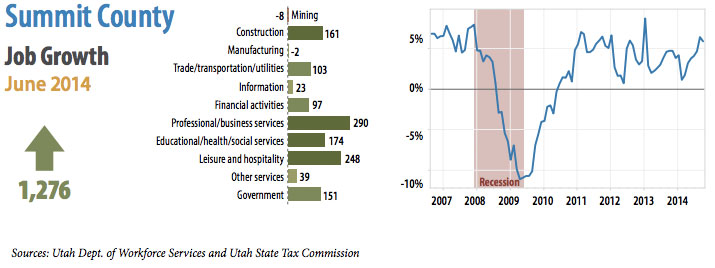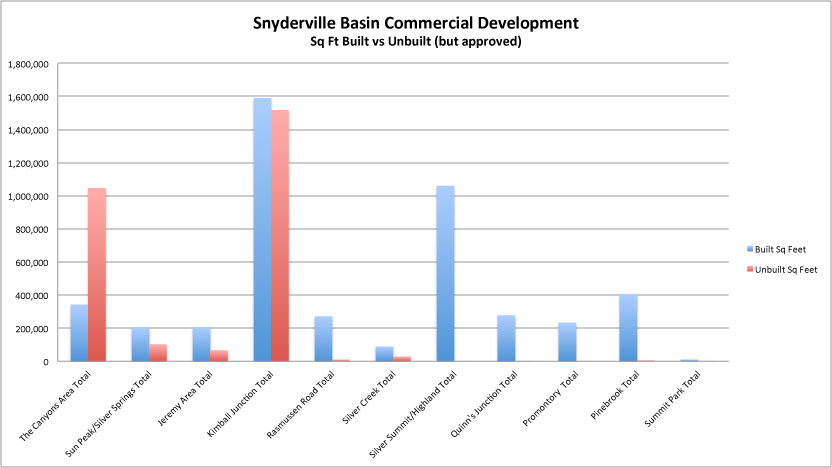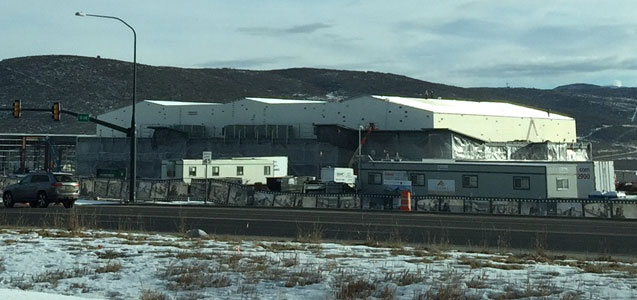Jeremy Ranch Citizens Demonstrate That You Can Make a Difference
During Tuesday’s Snyderville Basin Planning Commission meeting, regarding the next phase of the General Plan, 200 people filled the Ecker Hill Middle School Auditorium. It is likely 150 to 175 of those people were from Jeremy Ranch. In general, Jeremy Residents were concerned about their neighborhood receiving more development as part of a new concept called “receiving areas.” Receiving areas enable certain land owners to “send” development from their land to other places across the Snyderville Basin. While nothing has been set in stone, one of the proposed areas for sending development was a hill across from the Jeremy Store at the entrance to Jeremy Ranch.
To say that Jeremy residents were not enthusiastic about this idea would be an understatement. The evening began with the President of the Jeremy Ranch Home Owners Association reading a statement that criticized the plan for fundamentally altering the characteristics of a neighborhood that is well established. She said that “people live there for specific reasons” and a receiving area was not what they bought into. At one point she asked all residents from Jeremy Ranch who agreed with her statements to stand up. Gazing out into the crowd, we were hard pressed to find many people still in their seats.
Many of these Jeremy Ranch residents also chose to speak on their own behalf — so much so that Planning Commission head Colin DeFord said on multiple accounts “Jeremy Ranch, we hear your concerns.” The response shouted from the crowd, multiple times, was “yeah… but what are you going to do about it.” To his credit, Mr DeFord did a commendable job of managing a meeting that was tense at moments. He successfully balanced making sure public opinion was heard while trying to capture actionable items. On many occasions he would ask the speaker specifically how the speaker’s ideas could be incorporated into the General Plan. He was doing his best to focus the conversation on making the General Plan better.
However, Tuesday night belonged to Jeremy Ranch. The incorporation of a Jeremy Ranch receiving area into the General Plan struck a nerve. That nerve caused somewhere between 5-10% of the Jeremy Ranch’s 2000 residents to show up in solidarity. The official stance was that the Planning Commission would have to deeply consider what they heard from residents. However, perhaps Planning Commissioner Mike Franklin said it best when he said he felt the Planning Commission needed to take a hard look at whether they really wanted to make any area, that isn’t already heavily commercial-based, a receiving area.
From our view, we couldn’t be more thrilled. People became engaged in a topic that will impact them one way or another. Now they own part of the process … and that ownership has the potential to help us make a better Park City.
It was truly one of those nights that gets us excited about Park City’s future. Our community has a number of challenges ahead of us but this gave us hope that we can all work together to solve them. It also should give people the knowledge that they can individually make difference. Because of each of those persons that showed up on a random Tuesday in January, it is likely their hill will remain open space for the foreseeable future. That’s all they really wanted, and because they chose to get involved, they will likely get it.
We Live Blogged the Snyderville Basin Meeting on the General Plan Phase 2
We were at Ecker Middle School to cover the Snyderville Basin Planning Commission (SBPC) meeting regarding the General Plan Phase 2. Click read more below to read all the gory details. We will also be posting a video as soon as we can.
There is a Distrust of Summit County Government When it Comes to Development
We’ve followed the Snyderville Basin planning process in great detail for a while. Granted, by many people’s standards across the Basin, who have been here since the 60s, 70s, or 80s, we’ve only been here for a drop in the bucket. That said, we were so upset with some events a few years ago that we began going to every possible Planning Commission and County Council meeting we could.
During that time, we gained great respect for many of our county leaders. While we don’t always agree with their opinions, a reasonable person can see that our leaders are generally good people who try their best.
That said, as you talk to people across the community, many don’t share our opinion. They look at what Park City and the Basin has become (in their eyes) and blame that on the powers that be. In some ways, that is also reasonable. We have a representative government for a reason. Not everyone can provide input or attend every meeting and they depend on the people they elect, and thus the people the elected officials appoint, to make good decisions.
Often, the squeaky wheels get labeled as “crazies.” Yet, many of the people we’ve talked with don’t fit that mold. Other times, they are called tree-huggers, because they never met a business they liked. Yet, a decent portion of people we’ve talked to are worried about property-owners’ rights. They want to know when they can build what they want on their land. They frankly don’t trust Summit County to ever let them do what they think is their fundamental right.
Perhaps the best you can say is that if no one is happy, maybe something is being done correctly. Yet, that view doesn’t lead us to where we need to go as a community. We need to be able to have open conversations that are backstopped by trust in our government. That trust isn’t something that will be gained back overnight.
We believe the General Plan Phase 2 discussions are a great starting point, though. Often times the public will come together to provide input on topics. Yet the moment a citizen concludes their comment, it’s the last time they ever hear of what became of their idea or concern. The party line is that “ideas are incorporated” into the final plan. It’s frankly a copout.
What we hope happens is that every idea or concern is recorded by the Planning Commission and the Community Development Department. We then hope that each is discussed and a written response to each general idea (there are bound to be overlaps) is made available on the county’s website. Someone wants a 100 foot statue of Jesus straddling I-80 like the Colossus of Rhodes, don’t ignore the idea, tell them that’s really up to UDOT but that it would be dangerous…so it is not being considered by the county. Someone says we need to stop all development now. Tell them there are 2.7 million square feet of commercial space and 3,100 units of residential property that have already been approved. There’s nothing that can be done about existing rights, just like they wouldn’t want the county to confiscate their house or land.
Regaining trust is about treating people with respect, telling them when they are right and wrong, as well as providing good explanations that they understand. As part of that, it’s likely the county will learn something too. We understand that a process like the one suggested above will take a lot of time. However, if done well it goes a long way to help people understand not only their concerns but the concerns of others too… as well as why decisions are being made.
The alternative is to listen to 300 people speak at Tuesday night’s General Plan event, write down some of it, incorporate a little of it, and produce a new draft of the General Plan. That will leave people wondering if they were even heard and more importantly why they even showed up. They’ll feel like they weren’t part of the conversation and they will learn nothing… except that the county is just like they knew it was.
This really is a good opportunity to change a number of impressions across the Basin. We just hope the powers that be seize it.
Over 2.7 Million Square Feet of Commercial Development Has Been OK’d But Remains Unbuilt in the Basin
As we try to find solutions to balancing growth with our economy here in the Snyderville Basin, we often focus our discussion on homes. Where should we build condos? How many? When? Etc.
However, perhaps the more daunting task is looking at commercial development. So far there has been about 7.4 million square feet of commercial space approved in the Basin. As of December 2014, 4.6 million of that has been developed. That leaves over 2.7 million square feet of commercial space yet to come.
So, if you look around the Basin and say to yourself, “Wow, this place is filled with crap commercial offerings.” It’s actually only 65% filled. There is another 35% yet to be built (just with current entitlements).
Put another way, look at all the commercial development around you and then take 60% of that and add it to what we already have. Wow.
We’ll understand if now is the time you decide to say “I give up.” Figuring out solutions to our growth ain’t gonna be easy.
The Roof is On At Park City Film Studios
Over the weekend we noticed that the Park City Film Studios roof was finally “completed” — or it seems to be completely covered at least. During the past few months we have wondered what’s going on as we’d only see a few people working at any one time.
So, has hell frozen over? Has it been just nice enough outside to finally get it done? Are they trying to look good for Sundance? We don’t really know. We’re just glad the 19 inches of snow we got yesterday won’t be sitting inside the building, on the structure’s foundation.
What the Heck is a TDR? … And Why You Should Care.
If you’ve been following developments regarding the Snyderville Basin General Plan, you may have come across the concept of receiving areas. Receiving areas are parcels of land that are designated to have more building on them than would be normally allowed in order to concentrate development density. The flip side of receiving areas are called sending areas. Sending areas are parcels of land where an owner may have the right to build something but the local government would prefer they don’t. So, TDR programs enable a land owner to trade their current development rights in a sending area for TDRs. Those TDRs can then be sold to developers. Developers buy them because they can use TDRs to build with more density in receiving areas. Therefore, they can build more than if they relied on the normal zoning.
For example, perhaps someone owns 80 acres of land near Round Valley. The land is zoned for 1 house (unit) per 20 acres. So, the owner could build 4 houses there. The county then says, “We’d prefer to keep that all open space. Let’s make it a sending area.” The owner can then decide if they want to sell the right to build 4 houses for TDRs. If they do, the owner will deed restrict the land for “open space” and in return get TDRs. They then find a developer who wants to buy the TDRs so the developer can build at higher density at one of the Basin’s receiving areas, like Jeremy Ranch. That way, instead of building say 10 houses in Jeremy Ranch they can build 200 condos. It benefits the land owner because they are able to profit from the land. It benefits developers because they can build more than is normally allowed in one of the receiving areas. It can benefit citizens because certain land is protected from development.
We can see the draw of the TDR concept, as it does seem to be a way to protect land from development but also provides land owners with compensation. However, TDR programs can be overly complicated and sometimes don’t achieve the desired effect. Our issue with getting behind a TDR program in the Basin right now is that we don’t have enough information about it. It’s not enough for us to look at a land use map and see that lower Silver Creek could be a receiving area. What are the sending areas that would be traded for this land. Is it a worthwhile trade? What are the TDR’s rules. Will it be an even exchange on parcels or something like 16-1? How much development will get packed in to each receiving area? How do we prevent corruption of the process? We’re fearful that if we even support the idea of TDRs that it may become a run away locomotive and there won’t be a chance to stop it. Any time there is a lot of money to be made, its important to slow down and make sure that it is both done right and the expected outcome is desirable. We also want to be sure that strict ordinances are in place to ensure that 20 years down the line, program details aren’t forgotten and we have a mess on our hands.
We look forward to hearing more about the specifics of any proposed TDR plan in the Basin, but until then, we find it a hard concept to get behind.
Your County Needs Your Help
Over the past couple of years, Summit County (and the Snyderville Basin Planning Commission) have been working towards completing Phase 2 of its General Plan. The General Plan lays out the concepts that drive “what should be built where” in the Basin. The General Plan, once completed, is then used to update our development code. The development code is the legally binding document that controls and enables development.
A couple of weeks ago, an open house was held to try and explain the thinking behind the General Plan. On Tuesday, a Public Hearing will be held in order to get public input on the General Plan and its accompanying land use maps. Many residents we have talked to are up in arms over THE PLAN. However, what we all need to understand is that this is not a “done deal” yet. If it were a baseball game, we would still be in the second or third inning. We, the citizens, have the power to encourage the county to approve the plan, modify its contents, or scrap it altogether.
We firmly believe that both the Snyderville Basin Planning Commission and Summit County are open to listening to our opinions. So, we hope you will attend the meeting at Ecker Middle School at 6PM on Tuesday January 13th. We do have the power to change course. We just have to use that power wisely.
We’ll Be Live Blogging Tuesday Night’s General Plan Public Hearing
On Tuesday, the Snyderville Basin Planning Commission will be holding a public hearing to get input on Phase 2 of the Basin’s General Plan. This plan is VERY IMPORTANT as it will likely guide development for the next 25 years.
The meeting is at 6PM at Ecker Middle School (they moved it from the Richins Library due to the expected turnout). If you can attend in person, and provide input, that’s wonderful. If you can’t make it, we will be live blogging the meeting and will do our best to record it so you can watch later.
Check back on Tuesday night if you’d like to follow along with what your fellow residents are saying. We hope you see you there (or here).




